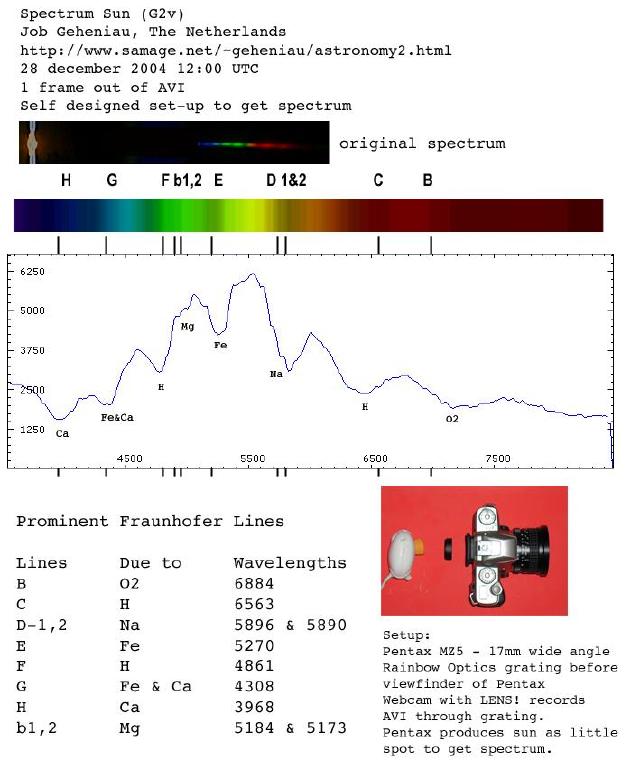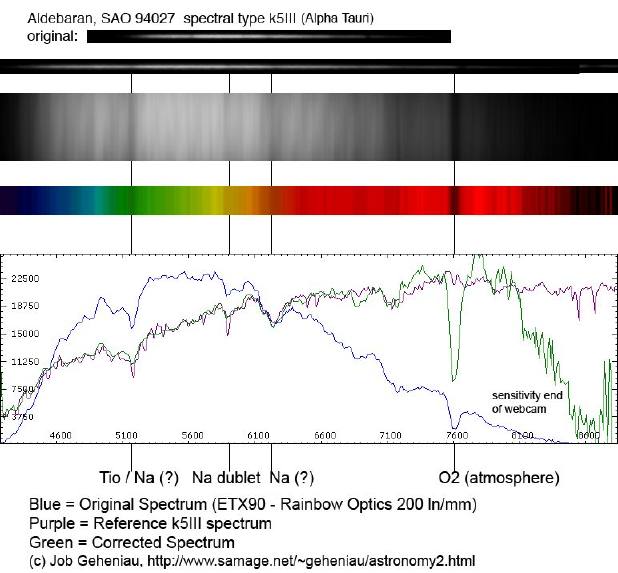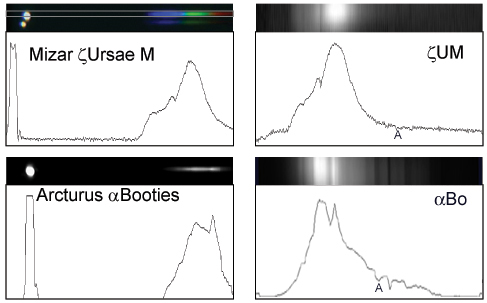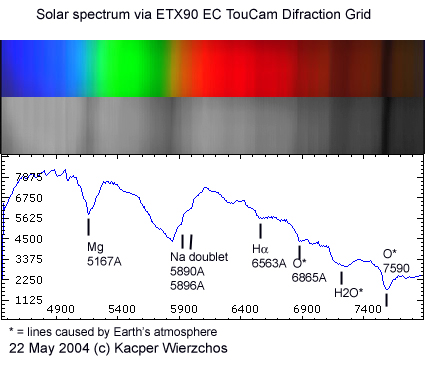Last updated: 31 December 2004
|
Last updated: 31 December 2004 |
Some ETX users have sent me examples of their astrophotography. If you have some examples you would like included here please send me a description of how you made the astrophotos and a copy of the images as GIF or JPEG files (due to internet email gateway issues, please send only one image file per message). Send to etx@me.com. Alternatively, if you have created your own web page with your examples please let me know and I'll include a link to your site.
| Submitted by: geheniau@xs4all.nl [31 Dec 04] |
|---|
|
Last few weeks I thought a lot to get a good solar spectrum.
To be honest, till now I can't find a way to do it with the ETX90.
Maybe you are willing to place this sunspectrum on your site, but if you
don't (because it's not an ETX image) I can understand that.
Tried a lot but nothing was really satisfying. I even tried the 1 cm hole
with razorblades before my ETX90 (the sun is too big and too bright to get
a spectrum)
No succes.
Finally today I found a good way!
I used my 17mm Pentax MZ5 with 17mm Wide angle lens. This produces the sun as tiny spot in the MZ5 viewfinder. Behind that I put the grating and with a NORMAL webcam with LENS! I make an avi. Focus with webcam lens for the spectrum. It really works! You can clearly see the Fraunhofer lines (Calcium, Natrium, H-alpha and O2) So no use of telescoop (it enlarges the sun instead of making it smaller.....) Attached my first results. Hope to improve this self thought way of recording sun spectra. |

|
| Submitted by: geheniau@xs4all.nl (geheniau@xs4all.nl) [6 Dec 04] |
| I found another nice spectrum I did. Especially the Natrium in this spectrum is nice to see. |

|
| Submitted by: geheniau@xs4all.nl [23 Nov 04] |
|
Attached some new spectra done with my ETX90 and Rainbow Optics grating.
3 different kinds:
1) Planetary nebula (look at OIII emission line, that's why we use OIII filters on watching planetary nebula) 2) Red Giant (Betelgeuse), with much molecular (Titanium Oxide) bands 3) White giant P Cygni with typical Ha band. I also attached 2 pictures of Kacper and Jacek Wierchos from Spain. They made 2 of the same spectral exposures with their new LX90. (We try to exchange some ideas, because not many people are doing this and it's hard to find some good information on the Internet about the way of working with VSpec for example) Just to compare that the ETX can easily qualify as spectral analysis machine with a 8' LX90. Because it's a new part of astronomy, maybe you are willing to put these 5 pictures on your spectrum site, although the LX90 is not an ETX, it's just nice to see the differnces and similarities of the spectra from the LX90 - ETX90. I am step by step learning about the spectra. But I just ordered a book " "Practical Amateur Spectroscopy Stephen F. Tonkin" to learn more, because it's quite difficult stuff, especially the theoritical part of it. |

|
| Submitted by: geheniau@xs4all.nl (geheniau@xs4all.nl) [19 Nov 04] |
| Attached a spectral analysis of Alkaid (Ursa Major). Comments in photograph. |

|
| Submitted by: Kacper Wierzchos (k2_71828@yahoo.es) [5 Nov 04] |
| I am very glad that Job Geheniau come to the new section of ETX Spectroscopy. I am sure that him contribution in this field will be very interesting and all together we will be able demonstrate that the spectroscopy with ETX scopes and web cams are possible and amazing. Here I am presenting the spectrum of Antares. ANTARES (Alpha Scorpii) is an M-class (Spectral Type M1V) red supergiant. Antares is about 700 times the diameter of our own Sun, 15 times more massive, and 10,000 times brighter with a diameter of approximately 6.24 x 108 km, or slightly more than the distance as from Sun to Mars(!) The distance is 604 light years. The spectrum of an M stars shows lines belonging to metals but hydrogen is usually absent. The spectrum was obtained with ETX90EC and TouCam in June of this year and was processed with Photoshop and Vspec. Note that obtained spectrum has a very good coincidence with reference spectrum of M1V class star after correction versus CCD sensitivity (operation performed by Vspec). By the way, from September I have a new scope LX90 and some astrophotography and spectroscopy (will come in near future even planetary nebula spectra) results could be seen on. |

|
| Submitted by: geheniau@xs4all.nl (geheniau@xs4all.nl) [28 Oct 04] |
|
Just like Jacek and Kacper Wierzchos I am starting with spectrum analysis
of stars and other objects with my ETX90.
I bought myself an Rainbow Optics diffraction grid (200 lines/mm) and a
Jeulin difraction grid (100 lines/mm) to try to get the fingerprints of the
stars.
Attached for your guest astrophotogray spectra list my first attempt
(thanks also to Jacek Wierzchos).
I have a lot to learn again especially with the program vspec. Quite difficult.
In the future I will give more information about the way of working to get
this kind of information. First I have to trial and error and study it
myself :-)
Greetings from Holland with rain-rain-rain during the moon eclips (had my alarm set at 4.00 am, but rain again so back to bed). |

|
| Kacper Wierzchos (k2_71828@yahoo.es) [13 Jul 04] |
| I have a new contribution for your Guest Galery: Spectra. This is Vega A0V class star spectrum with very nice 4 Hydrogen absorption bands. |

|
| Kacper Wierzchos (k2_71828@yahoo.es) [27 Jun 04] |
| I am sending to you the spectrum of two stars: Mizar and Arcturus. I consider this experiment as succesfull as you can observ in attached file. It is true that the resolution if these spectrum is low, but it is possible to find there some most intensive absorbtion lines of several elements and of course atmospheric (A) absorbtion lines of O2 and H2O. Few words about the procedure. I am using 100 lines/mm diffraction grid which is in distance about 3 cm from CCD chip of TouCam. With this assamble it is possible to record the image of the star and their spectrum (left side of the attached image). You can use CCD conditions as for planetary astrophotography or for low magnitude stars I have try long exp. mode (time: 0.5-5 sec.). You can take several spactral images in different CCD condition and also black and white (seems to be better work just in B/W mode). For higher resolution of images the spectrum were recorded alone on PC screen (wihtout star image as in right side of attached image). It is very important good focus of the spectrum image (not a star!). Later the spectrum images were procesed with Adobe Photoshop (streching) and on the end you I used Vspec softwere (http://astrosurf.com/vdesnoux/download.html) for obtain the spectrum and much more data (not presented). Here you can also find a nice information about Amateur Spectroscopy: www.astroman.fsnet.co.uk/spectro.htm. Mike, may be you can introduce a new part in your Guest Astrophotography Gallery called: Spectroscopy. Spectroscopy with ETX90EC is possible!!! |

|
| Kacper Wierzchos (k2_71828@yahoo.es) [31 May 04] |
| The weather here is not very good for night observation then I decide to dedicate some time for experiments with Sun light. Here I am attaching a clolour and black/white Sun spectrum images and spectrograph with wavelenght and some elements determination. For this experimet I have used ETX90EC and TouCam (Registax, Adobe Photoshop and Visual Spec programs for images processing and spectrum callibration respectively). The images were obtained in following meaner: just before CCD chip I have placed a diffraction grid (100 lines/mm) and I have recorded a small *.avi file (25 frames) of Sun spectrum proceeded from some sun reflex of TV antena (on the nighbord roof). I think this is the first approximation to get the spectrum of bright stars. I will inform you if it could be possible, but I hope yes. I hope you can put this first results of spectroscopy of our star in The Sun Gallery. |

|
| Kacper Wierzchos (k2_71828@yahoo.es) [30 Apr 04] |
| I'm sending an imago of the reflected solar spectrum in a window, its made with the TouCam, the Etx-90 and a Diffrection Light net->(its no easy to find) in the camera adapter, I think that its very interesting to find the lines, in my image you can see the lines of the Sodium, Hydrogen and Calcium and other lines in the blue. |

|
Return to the top of this page.
Go back to my ETX Home Page.